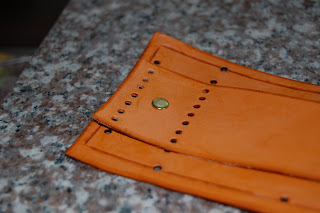Here we are at part two of our stitching series. Today we are going to discuss the Double Loop Stitch. This is the stitch that I have used the most in my leather craft projects. It sounds complicated at first but after a while it becomes really easy to understand and do properly. The most important thing to remember is to make sure the lace does not "kink" as you go. You just need to make sure the finished side of the lace is always facing up when the lace is pulled tight.
You start the stitch by pulling the lace through the "outside" hole and then looping it through the next hole like you are starting the basic loop stitch.
BUT before you pull the stitch tight put the excess lace through the loop you are about to pull to create X when you pull the loop tight. (NOTE: Do not pull this too tight. We need it to be a bit loose.)
Now you are going to put the needle under that X you created and pull the lace through and pull the stitch tight. (This one can be a bit tighter, except when we get to the corners, you will see why.)
Then pull the needle through the next hole and pull it through. You will see that it has created another X, to which you will pull the needle up through and repeat.

When you reach a corner things get a little tricky. Basically you need to stitch twice over again on each corner hole. Any "official" double loop stitch directions may say three stitches per corner hole but I think that is a bit overkill. Two stitches per corner hole should be fine. Basically you pull the needle through the hole like you normally would, pull up through the X like normal, then pull it through the same hole again. Pull it through the X like normal, THEN you can move to the next hole. Repeat with the rest of the holes on the corner. It isn't really that tricky when you think about it but it can be hard to do as sometimes the holes may not be able to fit the lace. In these cases you can use an awl and try to widen the hole a bit. (Or if you have a pen or something pointy to stick in the hole to widen it . . . Doug, I hear you snickering in the back . . .quit it.)
Finishing and splicing the double loop stitch is a little tricky. To this day I have to refer to my directions to get it right. (It makes sense because it is something you only do once or twice a project and if you only do a few projects a year you can forget it easily.) Because I'm working with leather more it is beginning to stick.
Splicing, actually, is very easy. You just put the needle between the leathers and pull it through on the "outside" of the project.
You do this about three or four holes away from where you were previously stitching. Continue with the "old" lace until you get to the "inside" hole that matches the "outside" hole you pulled the new lace through.
You pull the old lace up between the leathers then cut off the excess. Tuck it between the leathers and continue with the new lace. Simple really.
Finishing off the stitching is where it can get tricky. When you reach the end you need to stop about four holes from the end.
Using an awl or your needle you need to pull the excess lace from the begining of the stitch out from under the lace. (This is the excess you folded under the loop to create the "X".)
Then pull it through the hole and then down again through a loop that has been created. Now you should have this loop and the excess lace coming from hole in the leather. Pull this excess up between the leathers and cut the extra and tuck it back down.
Now continue to lace like normal. Eventually you will end up pulling the lace through a hole and it will leave you with a hole on the inside but no other hole on the outside. Here you take the lace and pull it up through that loop that is hanging from the beginning of the lace and then pull it through the last "X" you created with the end of the lace.
Do not pull that stitch tight! Now pull the lace back down through that loop, again not pulling it tight yet. Now you need to push the two ends as close together as possible.
After you are satisfied that you have closed the gap as well as you can you pull the stitches tight and then pull the lace through the last hole on the inside and up between the leathers through the stitching and pull it tight.
Cut the excess lace and tuck it down. You are now finished.
I know that last bit is complicated and I tried to put in as many pictures as I could to illustrate. If you have any questions please do not hesitate to contact me at:
theslackjaw@gmail.com
That's all I have for today. I have a few new projects on the horizon after I finish these past few and I can't wait to show them to you. Until then, Happy Crafting!
































































